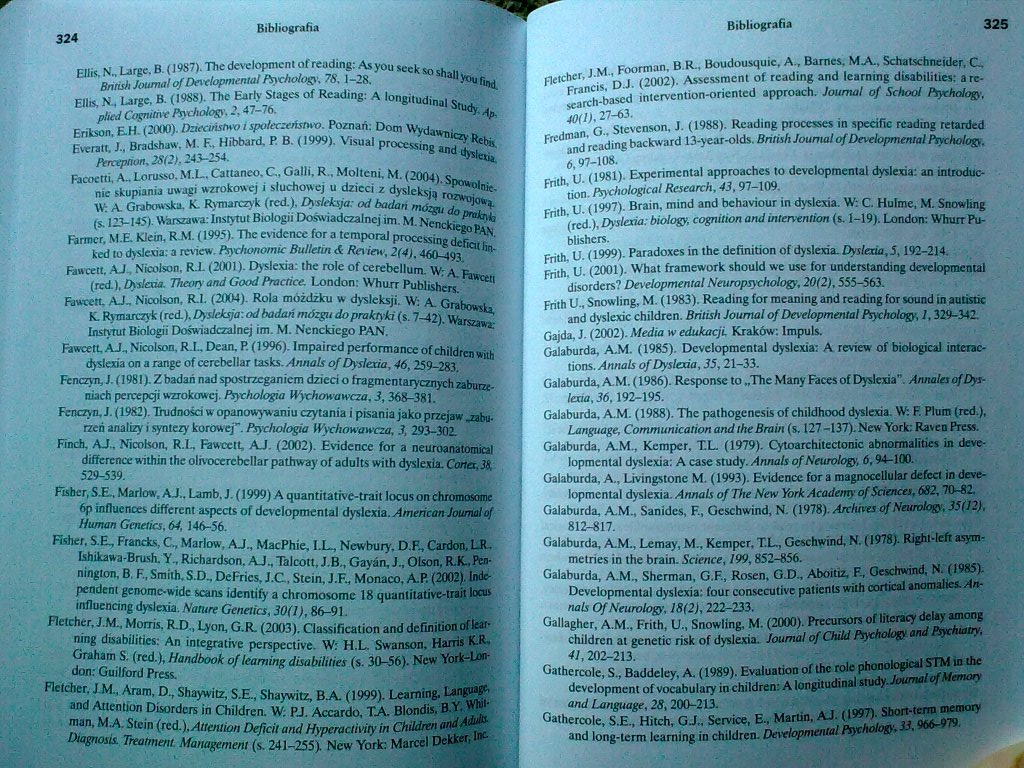Zdjęcie4034

324 Bibliografia
Ellis, N„ Largc, B. (1987). The devdopmcn( of reoding: As you scck so shall you &mL British Journal oj Dnrlopmental Psychdogy, 78.1-28.
Eflis, N.. Largc. B. (1988). The Eurly Stages of Reading: A longiludinal Study. 4;» płkd Cogmtnc toychology. 2,47-76.
Ęrikson. EH. (2000). Dzkaństwo t społeczeństwo. Poznań: Dom WydawniczyRebis. Eman. J., Bradshaw, M. F.. Hibbard. P. B. (1999). Ylsuąl processmg and dydciu Pmtpriort; 28(2t, 243-254.
Facoctt i, A.. Lorusso. M.L, Cauaneo. G, Galii. R . Moltcni. M. (2004). Spowolnienie skupiania uwagi wzrokowej i słuchowej u dzieci z dysleksją rozwojowy W A. Grabowska. K. Rymarczyk (red.). Dysteksja: od badań mózgu do praktyk ($. 123-145). Warszawa: Instytut Biologii Doświadczalnej im. M. Nenckiego PAN. Farmer. M.E Klein, R.M. (1995). The evidence for a tempo rai proccssing deficu hn-ked to dysleria: a review. Psychonomic Bulleiui <5 Re\iew, 2(4), 460-493. Fawcett, AJ;, Nicolson, RJ. (2001). Dysleria: the role of cerebellum. W: A. Fwcefl (red.), OysłauL Theotyand Good Practice. London: Whuir Publishers.
Fawcett, AJ„ Nicolson, RJ. (2004). Rola móżdżku w dysleksji. W: A. Grabowska. K. Rymarczyk (red.), Dyslekjja: od badań mózgu do praktyki (s. 7~42J.Wirsawa; Instytut Biologii Doświadczalną im. M. Nenckiego PAN.
Fawcett, AJ „ Nicolson, R.L, Dean, P. (1996). Impaired performance of childrcn »nh dyslcxia on a rangę of ccrebellar tasks. Annals of Dyslcaa, 46,259-283. Fcnczyn, i. (1981). Z badań nad spostrzeganiem dzieci o fragmentarycznych zabozc-niaefa percepcji wzrokowej. Psychologia Wychowawcza, 3,368-381.
Fenczyn, J. (1982). Trudności w opanowywaniu czytania i pisania jako przejaw Jafo rżeń analizy i syntezy korowej”. Psychologia Wychowawcza, 3, 293-302.
Finch, AJ„ Nicolson. R.L, Fawcett, AJ. (2002). Evidcnce for a neuroanatomial diffcrcnce within the olNocercbcIlar pathway of adults with dyslezla. Carter, m 529-539.
Fisbcr, S.E. Marlow, AJ., Lamb. J. (.1999) A quantitativc-trait lociis on chromosome 6p influence* differeniaspeets of devclopmental dysleria. AmeńcanJounid of Humań Genetks. 64,146-56.
Hsher, SE, Francis, C. Marlow, AJ„ MacPhie, I .L, Ncwbury. D.F., Cardon. LR. fahikawa-Brush. Y., Ricbardson, AJ., Tałcott, J.B., Gayan, J., Olson, RJC,Pen-nington, B. F., Smith. SD.. DeFrics, J.C. Stein, J.F., Monaco, A.P. (2002). H peodeni genome-wide seans identify a chromosome 18 quanthativcAiait kx» influenring dysleąia. Monar Genetks, 30(1), 86-91.
Fletcher, J.M., Morris, R.D., Lyon, G.R. (2003). Classification and definition oflear* ning dóabilities: An integratlve perspective. W: H.L. Swanson, Harris K.R, Graham S. (red.), Handbook of leaming disabilities (s. 30-56). New York-liM-don: Goilford Press.
Pletcber, IM., Aram, D., Shaywlć,S.E, Shaywitz, BA (1999). Leaming. | and AUeniłbn Disordcrc io Childreri. W; PJ. Accardó, TA. Blondis. B.Y. Wkit* map, MA Stein (mL\.Aaention Dcfkil and HypcmctMty in Children andAduh. Diagnosto. DratmetU. Management (s. 241-255). New York: Marcel Dekkar, lac.
fletchcr, J M , Foorman, B.R.. Boudousąuic, A.. Bamcs. MA. Sdatschneider. C, Francis. DJ. (2002). Assessracnt of reading and learning disabilities: a re-scarch-based intcrvention-oriented approach. Journal of School Psycholog?, 40(1). 27-63.
Frcdman, G., Stcvcnson, J. (1988). Reading proccsses in spedfic reading retarded and reading backward 13-ycnr-olds. British Journal of Developmental Psycholog?, 6,97-108.
Frith, U. (1981). Experimental approaches to developmental dysleria: an introduc-tion. Psychological Research, 43,97-109.
Frith, U. (1997). Brain, mind and behaviour in dysleria. W: C. Hulme, M. Snowling (red.), Dysleria: biology, cognition and intervention(s. 1-19). London: Whurr Pu-blishcrs.
[Frith, U. (1999). Paradoxes in the definition of dysleria.Dy$/ma, 5,192-214.
Frith, U. (2001). What framework should we use for understanding dcvelopmcntal disordcrs? Developmental Neuropsychologyt20(2), 555-563.
Frith Um Snowling, M. (1983). Reading for raeaning and reading for sound in autistic and dysleric children. British Journal ofŻ)evełopmental hychoiogy, 1,329-342. [Gajda. J. (2002). Media w edukacji Kraków: Impuls.
| Galaburda, AAL (1985). Devclopraental dysleria: A reriew of biotogical intcrac-tions. Annals of Dysleria, 35.21-33.
Galaburda, A.M. (1986). Responsc to „The Many Faces of Dysleria". AnnalaofDn-leda,36,192-195.
Galaburda, AM. (1988). The pathogenesis of childhood dysleria. W: F. Plum (red.), Language, Communication and the Brain (s, 127-137). New York: Raven Press.
Galaburda, AM., Kcmpcr. TL. (1979). Cytoarchitectooic abnormafities in de%e-lopmcntal dysleria: A case study. Annals of Neurolog?, 6,94-100.
Galaburda, A, Loingstonc M. (1993). Eridcnce for a magnocclluhi delea in dero-lopmental dysleria. Annals of The New York Acadenty of Sciences, 682,70-82.
Galaburda, AM., Sanidcs, F., Gcschwind, N. (1978). Archiśes of Neurolog?, 35(J2), 812-817.
Galaburda, AM„ Lcmay, M.. Kemper, TL, Gesdrpind. N. (1978). Rigfat-feft asym-metries in the brain. Science, 199,852-856.
Galaburda, AM.. Shcrman, G.F., Rósen, G.D. Aboitiz, F., Geschwind, N. (1985). Devclopmental dysleria: four consecutive patients wiih coriical anomalie*. ,4/i-nals Of Neurolog?, 18(2), 22Z-233.
Gallagher, A.M., Frith, U., Snowling, M. (2000). Prccuraors of litcracy delty among children at genetio rak of dysleria. Journal of Ould Psycholog? and Psychiatry, 41,202-213.
Gathercole, S., Baddelcy, A. (1989). Evaluation of the role phonological STM in the development of vocabulaiy in children: A longitudinai nudy. Journal of Memory and Language, 28,200-213.
Gathercole, S£., Hitch, OJ.. Scn-ice, E. Martin. AJ. (1997). Sbon-tcrm memoiy and łong-term learning in children. Dexdopmental Psycholog?. 33.966-979.
Wyszukiwarka
Podobne podstrony:
R III s 13 40 PRAC BADAWCZYCH, KTÓRE ZMIENIŁY OBLICZE PSYCHOLOGII Schneider, S., Morris. E. (1987).
324 GkeatBasin NaturalistMemoirsNo. 11 __ 1962. On the role of tlie symbionts in wood-de- stroying i
Zdjęcie4036 328 Bibliografia Hart. R-. Kcm-all. R (2001). Impaircd Processing of rapid stimulus sei
Zdjęcie4033 322 Bibliografia CostJes. Am Colthcart, M. (1996). Cognitive corrclalcs of dcvclopmcnul
XObiluary stratigraphy. Part I. Przegląd Geologiczny 35: 566-570. _1987 The application of
BIBLIOGRAPHIE Boulaire, J., Fotcdar, A. and Fotedar, R. The functions of the cdk-cyclin kinase inhib
30 Ewa K. Świętek BIBLIOGRAFIA 1. Cai Zongąi, Chinese Aesthetics: The Ordering of
Bibliographie 83 734. RENWICK (John). — The Catałogue of the łibrary of the collag
I Int roduction This bibliography has been compiled by the slaff of Informatics Inc. in response to
Sandland?4 p212 rM ALSO RESPON-SIBLE FOR THE THEFT OF TNF WATER. YOU
godzic1 Wiesław GodzićSocjologia wizualna oczami medioznawcy Realily leleuision is not the end of cw
htdctmw 079 Drawing the good guy is, as you can probably tell, a somewhat formularized task. But dra
więcej podobnych podstron